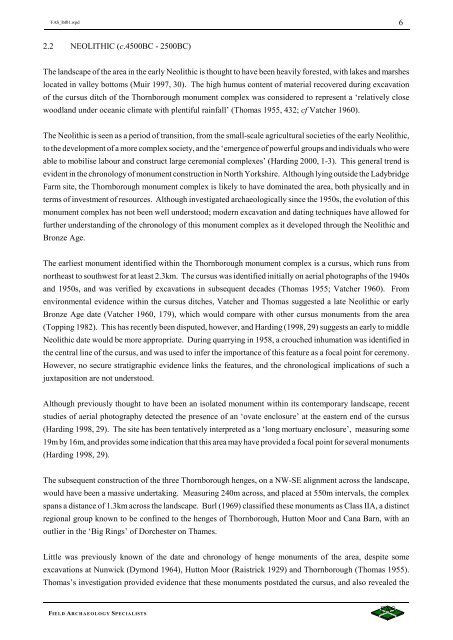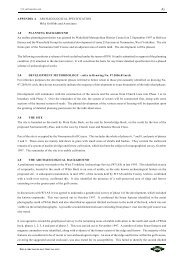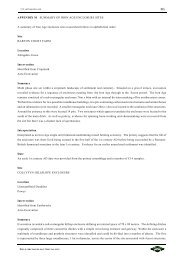ARCHAEOLOGICAL EVALUATION - Mike Griffiths and Associates
ARCHAEOLOGICAL EVALUATION - Mike Griffiths and Associates
ARCHAEOLOGICAL EVALUATION - Mike Griffiths and Associates
Create successful ePaper yourself
Turn your PDF publications into a flip-book with our unique Google optimized e-Paper software.
FAS_lbf01.wpd 6<br />
2.2 NEOLITHIC (c.4500BC - 2500BC)<br />
The l<strong>and</strong>scape of the area in the early Neolithic is thought to have been heavily forested, with lakes <strong>and</strong> marshes<br />
located in valley bottoms (Muir 1997, 30). The high humus content of material recovered during excavation<br />
of the cursus ditch of the Thornborough monument complex was considered to represent a ‘relatively close<br />
woodl<strong>and</strong> under oceanic climate with plentiful rainfall’ (Thomas 1955, 432; cf Vatcher 1960).<br />
The Neolithic is seen as a period of transition, from the small-scale agricultural societies of the early Neolithic,<br />
to the development of a more complex society, <strong>and</strong> the ‘emergence of powerful groups <strong>and</strong> individuals who were<br />
able to mobilise labour <strong>and</strong> construct large ceremonial complexes’ (Harding 2000, 1-3). This general trend is<br />
evident in the chronology of monument construction in North Yorkshire. Although lying outside the Ladybridge<br />
Farm site, the Thornborough monument complex is likely to have dominated the area, both physically <strong>and</strong> in<br />
terms of investment of resources. Although investigated archaeologically since the 1950s, the evolution of this<br />
monument complex has not been well understood; modern excavation <strong>and</strong> dating techniques have allowed for<br />
further underst<strong>and</strong>ing of the chronology of this monument complex as it developed through the Neolithic <strong>and</strong><br />
Bronze Age.<br />
The earliest monument identified within the Thornborough monument complex is a cursus, which runs from<br />
northeast to southwest for at least 2.3km. The cursus was identified initially on aerial photographs of the 1940s<br />
<strong>and</strong> 1950s, <strong>and</strong> was verified by excavations in subsequent decades (Thomas 1955; Vatcher 1960). From<br />
environmental evidence within the cursus ditches, Vatcher <strong>and</strong> Thomas suggested a late Neolithic or early<br />
Bronze Age date (Vatcher 1960, 179), which would compare with other cursus monuments from the area<br />
(Topping 1982). This has recently been disputed, however, <strong>and</strong> Harding (1998, 29) suggests an early to middle<br />
Neolithic date would be more appropriate. During quarrying in 1958, a crouched inhumation was identified in<br />
the central line of the cursus, <strong>and</strong> was used to infer the importance of this feature as a focal point for ceremony.<br />
However, no secure stratigraphic evidence links the features, <strong>and</strong> the chronological implications of such a<br />
juxtaposition are not understood.<br />
Although previously thought to have been an isolated monument within its contemporary l<strong>and</strong>scape, recent<br />
studies of aerial photography detected the presence of an ‘ovate enclosure’ at the eastern end of the cursus<br />
(Harding 1998, 29). The site has been tentatively interpreted as a ‘long mortuary enclosure’, measuring some<br />
19m by 16m, <strong>and</strong> provides some indication that this area may have provided a focal point for several monuments<br />
(Harding 1998, 29).<br />
The subsequent construction of the three Thornborough henges, on a NW-SE alignment across the l<strong>and</strong>scape,<br />
would have been a massive undertaking. Measuring 240m across, <strong>and</strong> placed at 550m intervals, the complex<br />
spans a distance of 1.3km across the l<strong>and</strong>scape. Burl (1969) classified these monuments as Class IIA, a distinct<br />
regional group known to be confined to the henges of Thornborough, Hutton Moor <strong>and</strong> Cana Barn, with an<br />
outlier in the ‘Big Rings’ of Dorchester on Thames.<br />
Little was previously known of the date <strong>and</strong> chronology of henge monuments of the area, despite some<br />
excavations at Nunwick (Dymond 1964), Hutton Moor (Raistrick 1929) <strong>and</strong> Thornborough (Thomas 1955).<br />
Thomas’s investigation provided evidence that these monuments postdated the cursus, <strong>and</strong> also revealed the<br />
FIELD ARCHAEOLOGY SPECIALISTS







